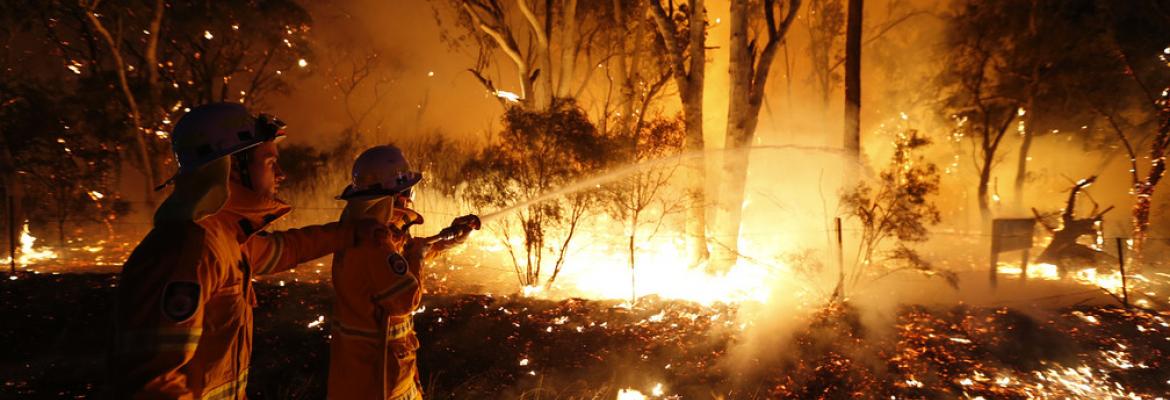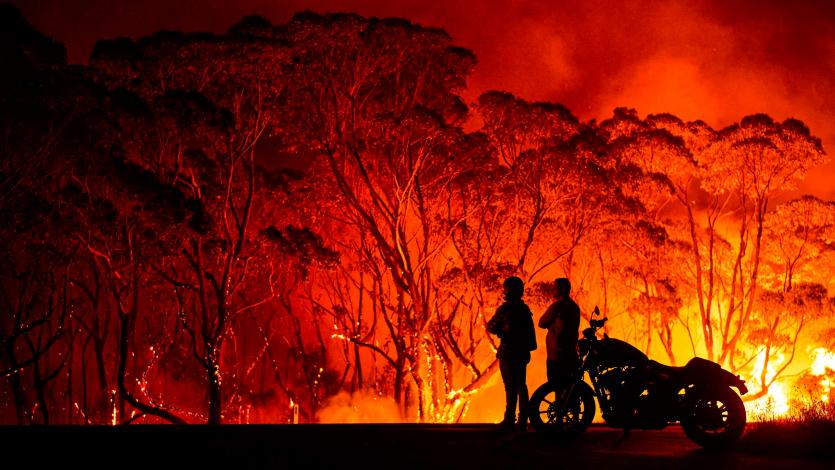Photo: Getty Images
 FEBRUARY 2020
FEBRUARY 2020
By Patryk Krych | The World Daily
The Burning Continent
There’s nothing unusual about a fire raging away in the blazing bush of Australia. The country has an entire “fire season”, where such bouts of blazing heat are expected, after all. But this year, the fires have been going much longer than usual – and it’s having devastating effects.
The fires have been going since as early as June of 2019 as evidenced by reports from Andree Withey of ABC News – one of the first reporters on the case, who had also noted that the bushfires had “started earlier” than their expected appearance during fire season, and speculated it as a cause of hotter and dryer climate conditions, likely a cause of the gradually changing climate across the world.
Since this initial outbreak, the flames had burned their way through fire season and are still burning in February of 2020, with uncontrollable and quick downwind bursts that have already led to the destruction of millions of hectares of land that the federal government is set to revise, as numbers are yet to be fully included from The Northern Territory – who have formally reported as of the 14th of January that 6.8 million hectares had been lost on their end. The Department of Home Affairs confirmed the reports to nine.com.au and the number of hectares has surely risen since, with the fires’ continuation.
“The biggest fire seasons in the past have burnt about 20% of the forest,” said Associate Professor Owen Price from the University of Wollongong. “But this time it is going to be more than half, which puts animals at a much higher risk. It’s a new record by any measure.”
With a new record of desolation comes a new record of deaths, especially in Australia’s animal wilderness. Since the 3rd of February, at least 34 people have been confirmed dead as a cause of the fires, and an estimated 1 billion lives have been lost among mammals, birds and reptiles with the loss of their natural environments and intense heat according to Chris Dickman, a biodiversity expert from the University of Sydney. His initial estimation had been around 480 million animal lives lost, but due to recent changes and possibly inconsistencies in his estimation, he now predicts at least double the numbers to be accurate.
Some online discussions have brought up the fact that the majority of fires in Australia are natural, a valid fact in itself, seeing as the environment is designed to regrow from ash as a country that’s experienced massive fires for centuries since its discovery. However, the record numbers of both deaths and acres burned have made this a worldwide, popular crisis. The fire is especially thought to be further undeniable evidence of climate change, following a Summer of record temperatures. Australia’s climate has been “abnormally dry” as of late, according to Dan Pydynowski, a senior meteorologist at AccuWeather who also that said “Everything is so dry right now, it doesn’t take much for a fire to spark and blow up and spread.”

Photo: Reuters
The department head at the Potsdam Institute for Climate Impact Research in Germany and a lead author of the United Nations’ Intergovernmental Panel on Climate Change’s Fourth Assessment Report: Stefan Rahmstorf, explained that there are two leading conditions for as to why the fires had gotten so out of control, and so quickly, those being heat and dry conditions. Two conditions that are known as a “well established” link to climate change. “Due to enhanced evaporation in warmer temperatures, the vegetation and the soils dry out more quickly,” says Rahmstorf. “So even if the rainfall didn’t change, just the warming in itself would already cause a drying of vegetation and therefore increased fire risk.”
By this point in time, in order for the fires to go out naturally or be easier to manage, a few weeks of rainfall would be necessary. However, with recent rainfalls in February being sparse overall, Pydynowski says it’s “not been impressive”, and will likely do little for the sake of putting out the fires, for which a certain level of prolonged dampness would be necessary.
So what’s being done about the disaster, if nature can’t handle the problem by itself? Thus far, every single state of Australia has experienced the fires to some degree this Summer, of varying damages and severity. It’s been thought to be the worst, however, along the stretches of both the Southern and Eastern coasts, where the majority of the Australian population live. Thus, at least an estimated 2000 houses have been burned and lost, leaving thousands more without a home. The Prime Minister Scott Morrison said in January that $1.4 billion (£1.1 billion) would be committed to the country’s recovery from the disaster over the course of the following two years. A portion of this money is going towards the creation of a recovery agency that will seek to assist those who have lost both their homes, as well as their businesses as a cause of the blazing fires.
A large part of the financial dedications are also going into the fire-fighting efforts themselves. The government has pledged to offer compensation for anyone willing to volunteer to take leave and go off to fight the bushfires, as well as more offered money for aircrafts capable of waterbombing the flames. There are thousands of fire fighters, some untrained and volunteering, all across Australia fighting the fires in various forms, some being regular strokes of flames, others being dangerous and malevolent infernos. It is unclear just how well the fires are being put under control thus far, seeing as the country is experiencing difficulties in keeping track with where and how the flames travel with changing windspeeds and varying ecosystems. According to the country's state fire services, there have been at least an estimated 3700 firefighters working on quelling the flames at any one time – a number spread all across Australia.
The worst hit state with the majority of firefighters working to stop the fires has been New South Wales, where the majority of houses had been lost, with over 2700 firefighters at any one time in the state when the fires were particularly destructive and vicious. "It's been an incredibly long campaign," said Ben Shepard, one of the many people in the service.
Thus far, the firefighters have used a combination of aircrafts and land-based-kit to combat the flames as best as they can, using the aircrafts for the purposes of waterbombing – using the air vehicle to drop water over the inferno, in hopes of dampening or even putting out the flames. The issue comes when the fires’ heat is so intense, it overwhelms the waters and they end up having little effect. In some areas, the blazes simply cannot be combated until they reach more manageable areas. According to the National Aerial Firefighting Centre, Australia has at least 500 aircrafts ready for firefighting purposes. Officials said that one such aircraft, a C-130 Hercules water-bombing plane, was thought to have been destroyed when they lost contact with it after it crashed into the snowy mountain in New South Whales, taking the lives of its three firefighters along with it, on the 23rd of January.
Meanwhile on the ground, heavy excavation equipment and vehicles are being used to dig up the earth and cut down parts of the forests, hoping to quell the flames before they can spread any further and prevent their travel. More than 750 vehicles are expected to be on the ground when the flames are escalating, or at their worst, said the NSW Rural Fire Service.
While the efforts to combat the fires are both crucial and hard-fought by those both on the ground, and in the air, the efforts have been met with their fair share of criticism – specifically towards the country’s government and its Prime Minister, who is well known for his support of the country’s coal industries, and his sceptical denial that the fires are in any way related to climate change. As well as this, people have also criticized the country’s slow response the to fires, only really beginning to stir up efforts around November and October time when they’d already spun far out of manageable control. He’s since expressed his regrets over the crisis, promising the money that would clear up the costs over the efforts, and claimed he’d seek a royal commission review.
The fires won’t go away on their own. 2019 has been the hottest year for the country in centuries, according to the last year’s published Australia state of the climate report, which stated that the “length of the fire season” would see an increased period of occurrence. Certain celebrities have already pledged their large donations to the fires, including singer Elton John, and Australian actor Chris Hemsworth. But the fires are still blazing, and more could always be donated towards the efforts. Donating can save lives, not only human but also those of the many animals whose ecosystems are being torn apart. To anyone willing, you can donate here and become an official part of the relief efforts.
By Patryk Krych | The World Daily






